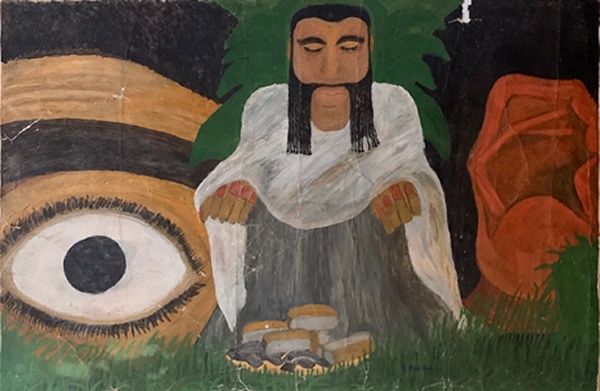Tanja Butler was born in Germany in 1955 and moved to the United States as a young girl. She studied art history and studio art and received a graduate degree in painting from the University at Albany, New York. Her work has been displayed in many solo and group exhibitions across the United States.

She is interested in the intersection of art and worship. Periods of work in Italy shaped her understanding of ways in which visual art can support the ministry of the church. The frescoes by Fra Angelico in the monastery of San Marco in Florence were a particularly influential model.
Her first body of liturgical work consisted of collections of graphic art published by Augsburg Fortress Publishers. She then became an artist-in-residence at Christ Church Episcopal, Wenham, and Christ the Redeemer Anglican Church in Danvers, Massachusetts. She is an Associate Professor of Art at Gordon College in Wenham, Massachusetts, where she teaches Painting, Printmaking, Illustration, and Liturgical Art. Students in her classes have created artwork for area churches, schools, and community organizations. She enjoys finding ways to create collaborative artwork within the context of community.
Work Process
My paintings are small in scale so that the viewer can interact intimately with the image. I typically transfer my sketches to masonite panels prepared with gesso, develop the first layer of paint with acrylics and complete the painting with oil paint to create a lustrous patina and richly saturated color. Collages often include pieces of printed fabric and painted paper.
Style
My work is meditative and devotional in nature. I reference visual traditions that use symbolic systems of stylization to describe an internal reality. Byzantine icons, for example, use an inverted perspective to portray space as if seen from the viewpoint of eternity. Cubist fragmentation of space is used to describe multiple perspectives as a metaphor of the transformation and growth initiated by the Spirit. American and European folk art, Persian manuscripts and textile patterns, African art, Early Christian art, Russian Suprematist paintings, and the Fauvist color palette are all sources of inspiration.
Content
These paintings were created as visual meditations to complement my reading of Scripture narratives. The stories are represented as multi-layered metaphors of God’s sojourn with us. My aim is to develop imagery that has the simplicity and clarity of a child-like vision, required, we're told, if we are to see the kingdom of God.

This autobiographical statement depicts a scene from the life of Abraham, in which he is called to leave the city and culture of his family, in order to seek God's presence in an uncharted wilderness. In a similar manner, I felt called to leave my training in the artistic culture of modernism behind to seek God's presence in an uncharted visual amalgam of various historic traditions.
Oil and acrylic on 10 by 8 inch masonite panel, cradled with 2 inch unstained birch plywood.

This is an autobiographical version of the Genesis account of Abraham and Sarah entertaining three angelic visitors. Christian tradition interprets this visit as a reference to the Trinity and an appearance of the pre-incarnate Christ. The painting contains visual quotes from the famous Trinity Icon by Andrei Rublev.
Oil and acrylic on 8 by 10 inch masonite panel, cradled with 2 inch unstained birch plywood.

Mary is represented with the unborn Christ, Light of the World, ready to “come forth from his pavilion, like a champion rejoicing to run his course” (Psalm 19:5). She holds a ladder, referencing both Jacob’s vision and the cross, the ladder of ascent between earth and heaven.
Acrylic paint, collaged painted paper and cotton fabric on 14 by 5 inch gessoed acid-free paper, no border, unframed.

The magi represent the cultures of the world, coming from the four corners of the earth to bring homage to the newborn King. The poses are drawn from royal Nigerian sculpture, Chinese paintings, and Persian manuscripts. The magi are forerunners of generations to come; all nations will bring the gifts of their unique cultures. In the bottom left corner Piet Mondrian offers his painting of chrysanthemums, an image reflecting natural order and creative stasis, the single-minded goal for which he sacrificed all nonessentials – a reminder of the determined search of the magi.
Oil and acrylic on 8 by 10 inch masonite panel, cradled with 2 inch unstained birch plywood.

The church waits for her bridegroom to appear. As she waits she celebrates her feasts of faith and dresses herself in expectation.
Oil and acrylic on 10 by 8 inch masonite panel, cradled with 2 inch unstained birch plywood.
Images of her work can be found on the Gordon College website at: http://www.gordon.edu/
Permanent Work/Collections:
Vatican Museum of Contemporary Religious Art, Florence Portfolio
Armand Hammer Museum of Art, Grunewald Center for Graphic Arts, UCLA, Florence Portfolio
DeCordova Museum, Lincoln, MA, The Nature of Things print portfolio
Smith College Museum of Art, Northampton, MA, The Nature of Things print portfolio
Boston Public Library, MA, The Nature of Things print portfolio
Portland Museum of Art, ME, The Nature of Things print portfolio
Graham Center Museum, Wheaton IL, twelve paintings
National Conference of Roman Catholic Bishops, Washington DC, four paintings
Albany Medical Center Chapel, Albany NY, seven paintings
Works in Publication:
Judith Dupre, Full of Grace: Encountering Mary in Faith, Art, and Life, Random House, 2010. “Annunciation” reproduced.
Salt of the Earth: The Christian Seasons Calendar 2011, United Church of Canada, Vancouver, BC, www.uhill.net. “The Magi and Mondrian” and “Burning Bush” reproduced.
Tanja Butler, Icon: Visual Images for Every Sunday, Augsburg Fortress, 2001.
CD-Rom of 600 images based on the church year and lectionary readings for use in congregational bulletins and self-published materials.
Lectionary for Worship: Revised Common Lectionary, Ritual Edition, Augsburg Fortress, 1996. Produced the embossed cover design, inside cover, and blockprint illustrations.
%20(1).png)











.jpeg)
